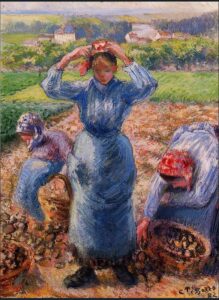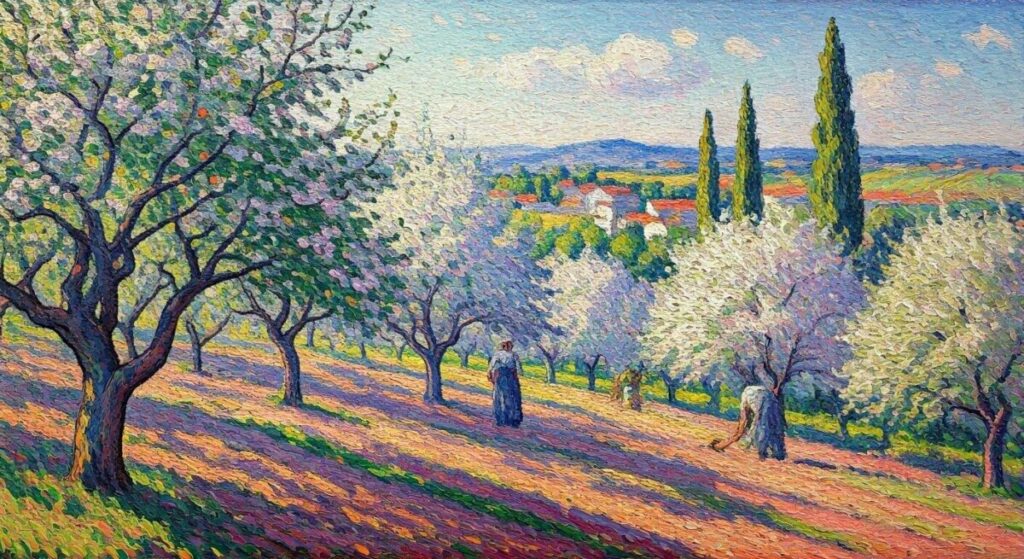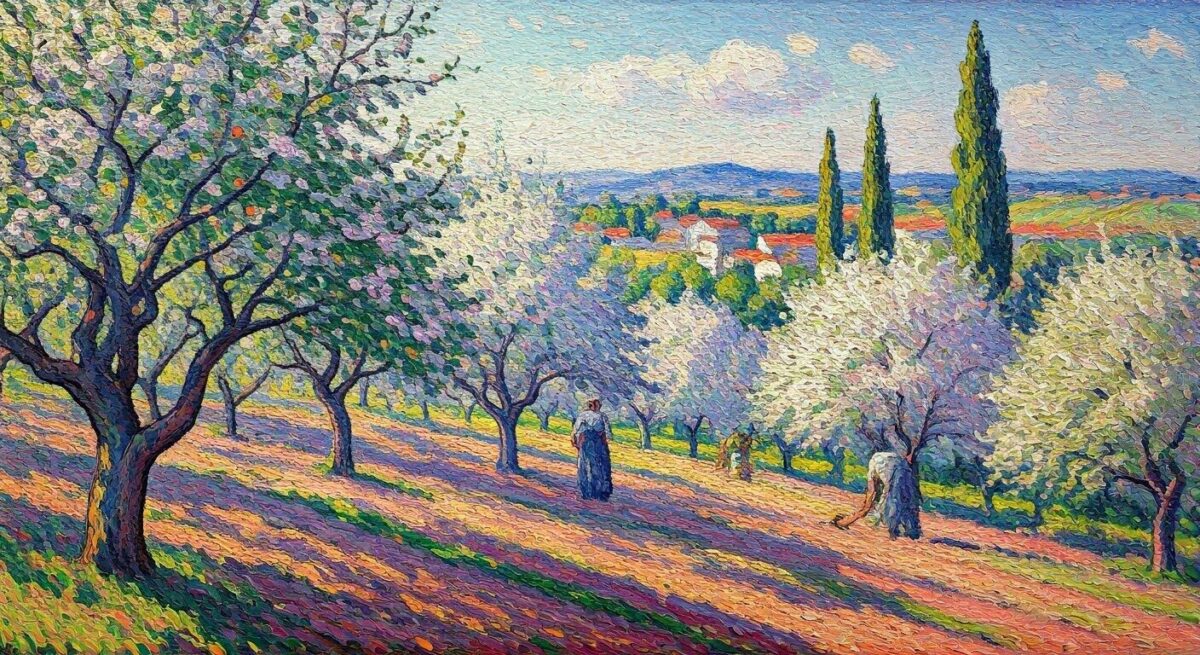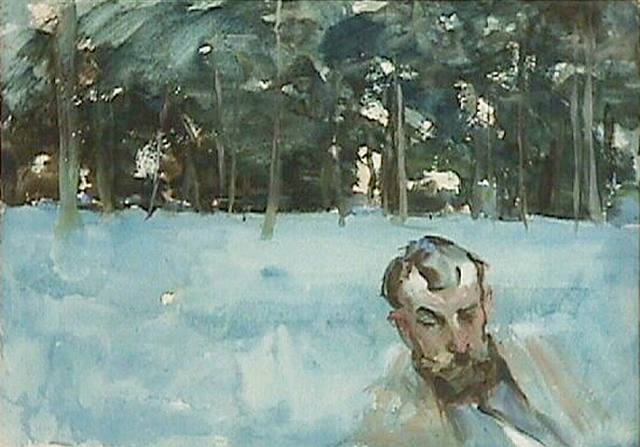Camille Pissarro paintings transport us to a world where rural fields glow golden in the afternoon sun and busy Paris streets buzz with life. Known as the “Father of Impressionism,” Pissarro captured everyday scenes with remarkable sensitivity and a revolutionary painting style. His works show us both peaceful countryside views and the energy of growing cities during a time of great change in France. Unlike many artists of his day, Pissarro found beauty in ordinary moments—farmers working in fields, market days in small towns, and the changing seasons across the French landscape. His paintings teach us to see the extraordinary in everyday life through his special way of using color and light.
Key Points About Camille Pissarro’s Art:

- Danish-French artist who became a central figure in the Impressionist movement
- Specialized in rural landscapes, scenes of peasant life, and urban cityscapes
- Pioneered plein air (outdoor) painting techniques
- Experimented with Pointillism and Neo-Impressionism
- Mentored other famous artists including Cézanne and Gauguin
- Created approximately 1,500 paintings during his lifetime
- Documented changing French society during the late 19th century
The Life Behind Camille Pissarro Paintings
Camille Pissarro was born in 1830 on the island of St. Thomas (then a Danish colony) to a French-Jewish father and a Creole mother. Unlike many artists who came from wealth, Pissarro’s background gave him a deep appreciation for working people. After moving to France as a young man, he studied under several established painters but eventually broke away from traditional styles.
What makes Pissarro special is how he combined his artistic talent with genuine concern for regular people. He often painted farmers, field workers, and market vendors with dignity and care. His political views leaned toward anarchism and equality—beliefs that influenced what he chose to paint and how he portrayed people in his art.
“Work at the same time on sky, water, branches, ground, keeping everything going on an equal basis… Don’t be afraid of putting on color… Paint generously and unhesitatingly, for it is best not to lose the first impression.”
Camille Pissarro
Pissarro lived and painted during a time when France was changing rapidly. The industrial revolution was transforming both city and country life. His paintings document this important period in history, showing both traditional rural practices and modern urban development.
Famous Camille Pissarro Paintings That Capture Rural Life

Pissarro’s rural scenes form the heart of his artistic legacy. He found endless inspiration in the French countryside, particularly in areas like Pontoise and Louveciennes where he lived for many years.
In paintings like “The Harvest” and “Peasants Planting Potatoes,” we see Pissarro’s deep respect for agricultural work. Rather than romanticizing rural life, he showed it truthfully—the hard physical labor alongside the natural beauty of the landscape.
What makes Pissarro’s landscape paintings unique is how he captured changing seasons and weather conditions. He might paint the same view multiple times to show how it looked in spring, summer, autumn, and winter. This approach reflects the Impressionist interest in capturing moments in time rather than creating idealized landscapes.
Some of his most beloved rural scenes include:
| Painting Title | Year | Notable Features |
|---|---|---|
| The Harvest | 1876 | Golden wheat fields, workers with gentle afternoon light |
| Apple Picking | 1881 | Orchard scene showing typical agricultural activity |
| Hay Harvest at Éragny | 1901 | Late-career work with rich color harmonies |
| The Garden at Pontoise | 1877 | Intimate view of rural domestic space |
| View of Bazincourt | 1894 | Landscape showing village integration with nature |
These paintings show Pissarro’s mastery at capturing the atmosphere of a place—not just how it looks, but how it feels to be there.
Pissarro’s Boulevard Montmartre Series: Capturing City Life

While known for his rural scenes, Pissarro also created remarkable cityscapes, particularly in his later years. Due to an eye condition that made outdoor painting difficult in cold weather, he began painting urban scenes from hotel windows in Paris.
His most famous urban works are the Boulevard Montmartre series, painted in 1897. From his room at the Grand Hôtel de Russie, Pissarro created 14 paintings of the same street view under different weather conditions and times of day.
These paintings show horse-drawn carriages, pedestrians, and the busy energy of Paris during a time of great change. The boulevard appears sometimes sunny, sometimes rainy, sometimes in morning light, and sometimes at sunset—each creating a different mood and atmosphere.
What makes these works special is how Pissarro captured movement and energy with small brushstrokes. He shows us Paris as a living, breathing place rather than a static postcard view. These paintings connect to modern urban landscape art that would develop in the 20th century.
Painting Techniques and Style Evolution
Throughout his career, Pissarro constantly experimented with new techniques and approaches. His early work shows the influence of Barbizon School painters and Corot, with relatively traditional landscape approaches.

As Impressionism developed, his brushwork became looser and more focused on capturing light effects. He worked primarily outdoors (en plein air), painting directly from nature rather than in a studio.
In the mid-1880s, Pissarro briefly adopted Pointillism (also called Divisionism), a technique developed by Georges Seurat that used tiny dots of pure color placed side by side. While he eventually returned to a more traditional Impressionist approach, this experimental phase shows his openness to new ideas even later in life.
Pissarro’s painting techniques include:
- Brushwork: Typically loose and expressive, becoming more structured during his Pointillist period
- Color use: Naturalistic but vibrant, with special attention to atmospheric effects
- Composition: Often balanced and harmonious, with careful attention to spatial relationships
- Light effects: Master at capturing different qualities of light throughout the day and seasons
- Perspective: Frequently used high vantage points, especially in urban scenes
Seasonal Changes in Pissarro’s Landscapes

One of the most distinctive aspects of Camille Pissarro paintings is how they capture the changing seasons. Unlike academic painters who often created idealized landscapes, Pissarro was interested in how places actually looked during different times of year.
His winter scenes show snow-covered villages with delicate gray-blue shadows and chimney smoke rising from cottages. Spring paintings burst with fresh greens and flowering trees. Summer landscapes glow with warm light and abundant vegetation. Autumn works capture golden and orange hues as nature prepares for winter.
This attention to seasonal changes connects to larger themes in Impressionist landscape painting about time, impermanence, and natural cycles. It also reflects scientific interests of the period in documenting and categorizing natural phenomena.
Pissarro’s Influence and Legacy
Though sometimes overshadowed by contemporaries like Monet and Renoir in popular recognition, Pissarro’s influence on art history is profound. He was the only artist to show his work at all eight Impressionist exhibitions between 1874 and 1886.
More importantly, Pissarro served as a mentor and guide to many younger artists. Paul Cézanne called him “a father to me, a man to consult and a little like the good Lord.” Vincent van Gogh and Paul Gauguin also learned from him.
Today, Camille Pissarro paintings are held in major museums worldwide, including:
- The Metropolitan Museum of Art (New York)
- Musée d’Orsay (Paris)
- National Gallery (London)
- Art Institute of Chicago
- Museum of Fine Arts (Boston)
A video tour of Pissarro’s works at the Musée d’Orsay:
Why Camille Pissarro Paintings Matter Today
More than a century after his death in 1903, Pissarro’s work continues to resonate with viewers. His paintings remind us to notice beauty in ordinary scenes—changing light on a hillside, busy street life, or workers in a field.
In our fast-paced digital world, Pissarro’s careful observations of nature and human activity encourage us to slow down and really see our surroundings. His democratic vision—finding artistic value in common people and everyday places—feels especially relevant today.
Environmental concerns also make Pissarro’s landscapes more poignant. His rural scenes document traditional farming practices and landscapes that have largely disappeared due to industrialization and development. They serve as visual records of a vanished world and remind us of our connection to the land.
Camille Pissarro paintings demonstrate that great art doesn’t need dramatic subjects or grand historical themes. Sometimes the most profound artistic statements come from paying close attention to the world around us and finding meaning in the ordinary moments that make up our lives.
FAQ About Camille Pissarro Paintings
Who taught Camille Pissarro to paint?
Pissarro initially studied under Danish painter Fritz Melbye in St. Thomas. After moving to Paris, he studied at the École des Beaux-Arts and Académie Suisse. He was significantly influenced by Camille Corot, Gustave Courbet, and Jean-François Millet, though he developed his own style that eventually broke from their teachings.
How much is a Camille Pissarro painting worth?
Pissarro paintings vary widely in value depending on size, subject, period, and condition. Major works have sold at auction for between $4 million and $32 million. His 1897 painting “Le Boulevard Montmartre, Matinée de Printemps” sold for £19.9 million (approximately $32.1 million) at Sotheby’s in 2014, setting a record for his work.
Why did Pissarro paint rural scenes?
Pissarro painted rural scenes because he had deep respect for agricultural workers and village life. His political beliefs leaned toward anarchism and social equality, which made him sympathetic to working people. Additionally, he found artistic inspiration in the natural rhythms of rural life and the changing seasons that were most visible in countryside settings.
What makes Pissarro different from other Impressionists?
Pissarro stands out among Impressionists for his focus on rural labor and working people rather than leisure activities. He was also more politically engaged, with anarchist sympathies that influenced his subject choices. Technically, Pissarro was more experimental than some peers, embracing Pointillism temporarily before returning to Impressionism. Finally, he served as a mentor figure to many artists, including Cézanne and Gauguin, earning him the nickname “Father of Impressionism.”
How many paintings did Camille Pissarro create?
Camille Pissarro was extremely prolific, creating approximately 1,500 paintings during his lifetime. He also produced around 5,000 works on paper, including drawings, prints, and watercolors. This extensive body of work documents rural and urban France during a period of significant transition in the late 19th century.



